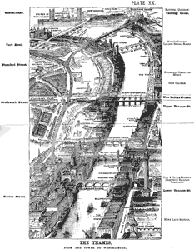






| Sherlock Holmes, Victorian Gentleman | ||||||
In 1891, Sherlock Holmes was a character very much of his time and place, who appealed to British readers directly by confronting the messy, changeable world they lived in. Rather than dwelling in romance or in an idealized past, as many of Arthur Conan Doyle's other characters did, Holmes was grounded squarely in Victorian London. The Sherlock Holmes mystery stories, written over a forty-year span from 1887 to 1927, represented the good, the bad, and the ugly of Victorian society: its ideals, its accomplishments, and its deepest fears. Arthur Conan Doyle's birth year, 1859, fell 22
years into Queen Victoria's 64-year reign, a time of unparalleled
growth and optimism for the British Empire. Resources and labor
taken from colonies worldwide had made England prosper, and the
time of serious independence struggles lay in the distant future.
Business flourished, technology blossomed, and London grew at a
great rate—from one million people to six in the space of a century—creating
problems of urban overcrowding familiar to us today: poverty, homelessness,
drug abuse, crime. While the great divide between rich and poor
and the economic and human strain of maintaining the colonies exacerbated
social problems that were as yet insoluble, Victorian Britons, led
by Victoria's husband Albert, put their faith in technology and
science. The contrasts and conundrums of this fascinating time provided
Conan Doyle with the raw material and the backdrop for Sherlock
Holmes: a man of science, undistracted by the gentler passions,
who moved easily through the disquieting urban space, using his
wits to solve its moral and practical dilemmas. Physically, London could be a place of disturbing
contrasts, a cosmopolitan city where the middle class drank tea
in comfortable drawing rooms while epidemics of typhoid and cholera
ravaged the squalid, overpopulated East End. The putrid Thames River,
the city's main source of drinking water, despite the network of
open sewers that dumped tons of waste into it daily, carried a reeking
cloud of contagion to all levels of society as it meandered through
the heart of the city. | ||||||

